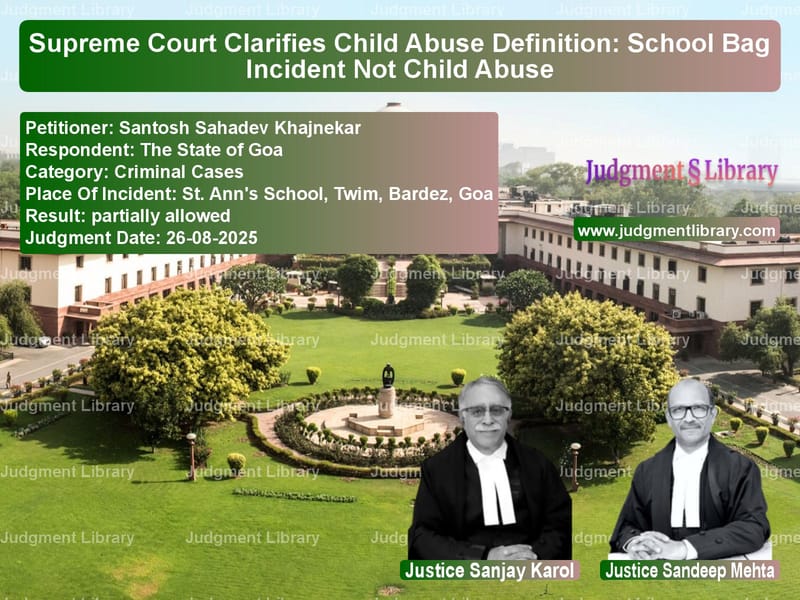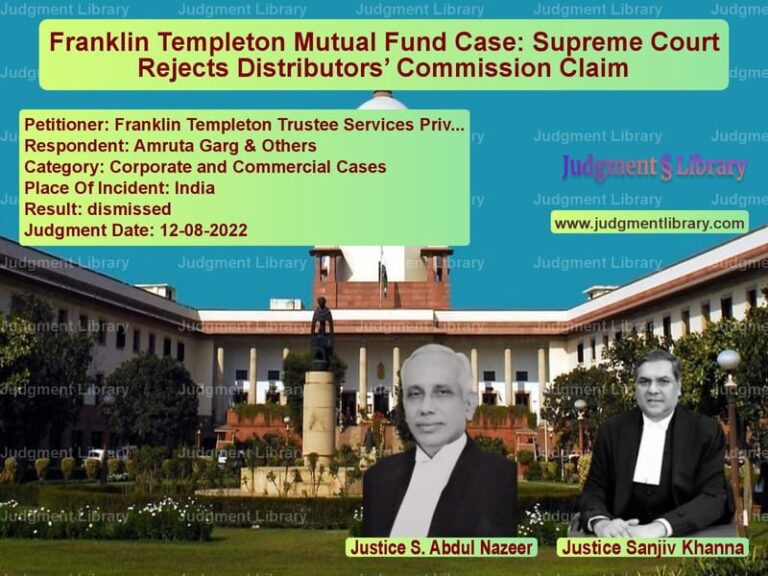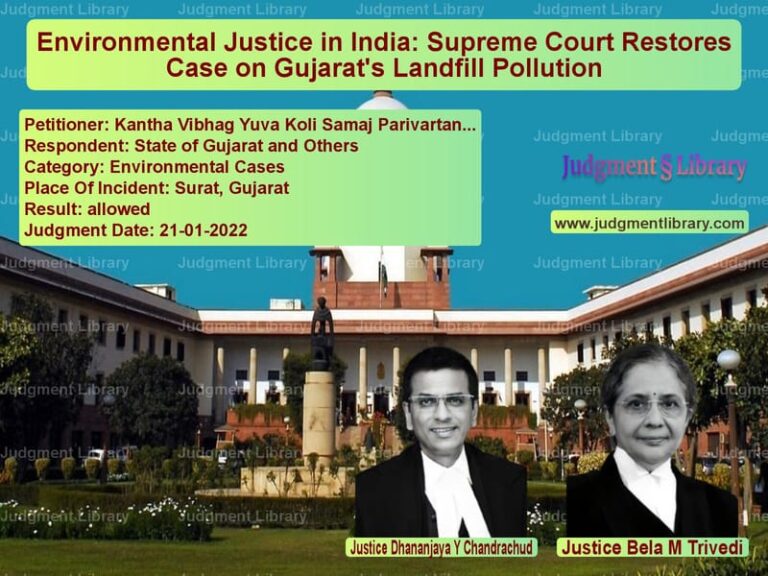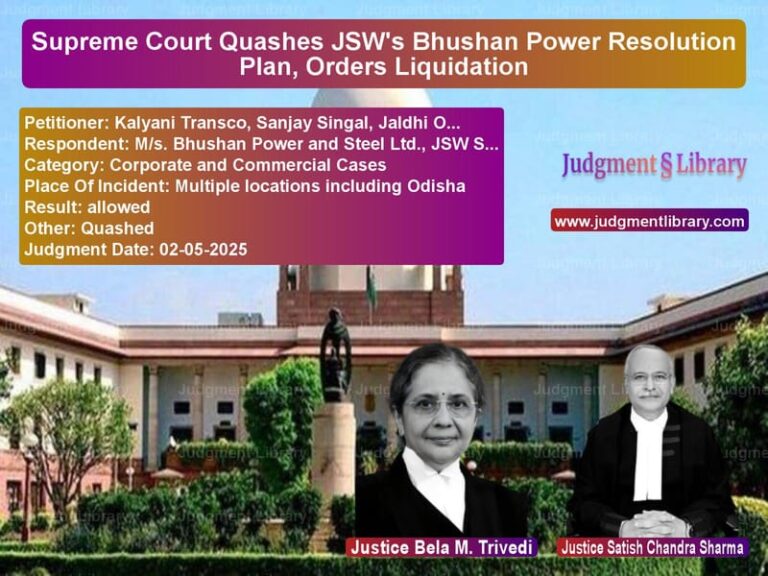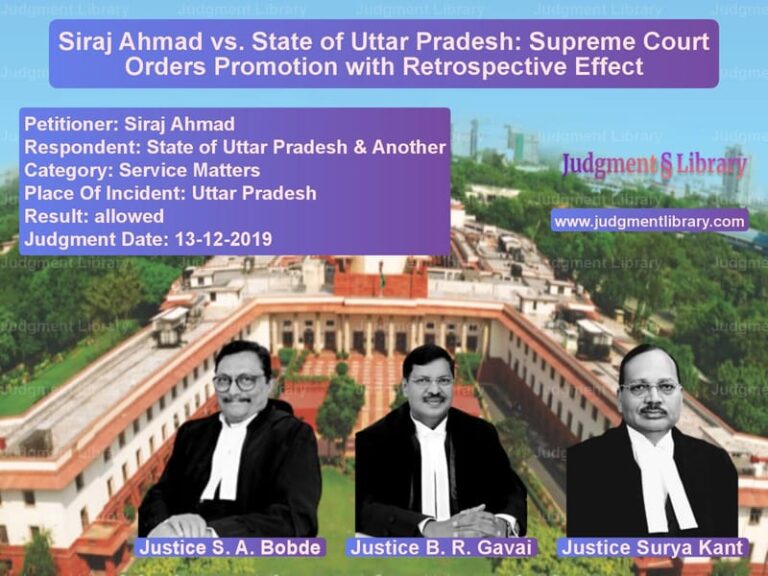Supreme Court Clarifies Child Abuse Definition: School Bag Incident Not Child Abuse
In a landmark judgment that clarifies the boundaries of child protection laws, the Supreme Court has acquitted a man who was convicted under the stringent Goa Children’s Act for hitting a child with a school bag during a scuffle. The case involved Santosh Sahadev Khajnekar, a laborer who faced serious criminal charges including child abuse for an incident that occurred at St. Ann’s School in Goa back in 2013.
The incident took place on February 1, 2013, at around 8:00 AM in the premises of St. Ann’s School in Twim, Bardez, Goa. According to the prosecution, Khajnekar had hit a child with a school bag belonging to his own son during what appeared to be a sudden altercation. However, the First Information Report (FIR) was lodged only after a delay of eight days on February 9, 2013, raising questions about the timing and circumstances of the complaint.
The trial court had convicted Khajnekar under multiple sections of the Indian Penal Code and, most significantly, under Section 8(2) of the Goa Children’s Act, 2003. He was sentenced to rigorous imprisonment for one year and fined Rs. 1,00,000 for the child abuse charge, along with additional sentences for offences under Sections 323 (voluntarily causing hurt), 352 (assault or criminal force), and 504 (intentional insult with intent to provoke breach of peace) of the IPC.
When Khajnekar appealed to the Bombay High Court at Goa, the court showed some leniency by substantially reducing his sentences. The child abuse conviction was reduced from one year of rigorous imprisonment to just 15 days of simple imprisonment, and the fine was reduced from Rs. 1,00,000 to Rs. 15,000. However, the core conviction under the child abuse law remained, prompting Khajnekar to approach the Supreme Court.
The Supreme Court’s Groundbreaking Interpretation
The Supreme Court, comprising Justices Sanjay Karol and Sandeep Mehta, delivered a judgment that fundamentally reinterprets what constitutes ‘child abuse’ under protective legislation. The Court carefully examined the definition of child abuse under Section 2(m) of the Goa Children’s Act, which states that child abuse refers to “the maltreatment, whether habitual or not, of the child which includes any of the following: (i) psychological and physical abuse, neglect, cruelty, sexual abuse and emotional maltreatment; (ii) any act by deeds or words which debases, degrades or demeans the intrinsic worth and dignity of a child as a human being; (iii) unreasonable deprivation of his basic needs for survival such as food and shelter; or failure to immediately give medical treatment to an injured child resulting in serious impairment of his growth and development or in his permanent incapacity or death.”
The Court made a crucial observation that would become the foundation of its judgment: “On a bare perusal of the above provisions, it is evident that the offence of ‘child abuse’ as provided under section 8 cannot be attracted to every trivial or isolated incident involving a child, but must necessarily co-relate with acts involving cruelty, exploitation, deliberate ill-treatment, or conduct intended to cause harm. The legislative intent is to protect children against serious forms of abuse and not to criminalise minor, incidental acts emanating during the course of simple quarrels.”
This interpretation marked a significant departure from how the lower courts had applied the child protection law. The Supreme Court emphasized that the law was meant to address serious, intentional harm rather than minor incidents that might occur during ordinary conflicts.
Analyzing the Specific Incident
The Court closely examined the facts of the case and found that “the only allegation against the appellant as borne out from the statement of PW-3, the injured child is that the appellant hit him with the school bag belonging to his own son. Even if we accept the injured child’s version in entirety, it would still not be sufficient to hold the appellant guilty for the offence of ‘child abuse’ punishable under Section 8 of the Act of 2003.”
The judgment highlighted the essential element of intention that must be present for an act to qualify as child abuse. The Court stated: “The offence of child abuse necessarily presupposes an intention to cause harm, cruelty, exploitation, or ill-treatment directed towards a child in a manner that exceeds a mere incidental or momentary act during a quarrel. A simple blow with a school bag, without any evidence of deliberate or sustained maltreatment, does not satisfy the essential ingredients of child abuse. To invoke the penal consequences of such a serious offence in the absence of clear intention or conduct indicative of abuse would amount to an unwarranted expansion of the provision.”
The Court also noted significant weaknesses in the prosecution’s case, particularly regarding the medical evidence. Dr. James Jose, the Medical Officer who examined the injured child, had admitted during cross-examination “that the possibility of the injuries being caused due to a fall cannot be ruled out.” This admission further weakened the case against Khajnekar.
Overturning Other Convictions
The Supreme Court didn’t stop at acquitting Khajnekar of the child abuse charge. It also examined his conviction under Section 504 of the IPC (intentional insult with intent to provoke breach of peace) and found it unsustainable. The Court observed: “Furthermore, we are of the view that both the Courts below committed grave error in convicting the appellant for the offence punishable under Section 504 IPC, as the said provision could only be invoked if the abusive or insulting language used by the accused against the injured child was intended to provoke breach of peace. Ex-facie, the alleged act of the appellant in abusing the child could not be construed to be such which was intended to provoke breach of peace. Hence, conviction of the appellant for the offence under Section 504 IPC is also unsustainable in facts as well as in law.”
However, the Court maintained Khajnekar’s conviction for the lesser offences under Sections 323 (voluntarily causing hurt) and 352 (assault or criminal force) of the IPC. But instead of sending him back to prison, the Court applied the Probation of Offenders Act, noting that “the offence punishable under Section 323 IPC carries maximum punishment of simple imprisonment for one year whereas offence punishable under Section 352 IPC carries maximum punishment of imprisonment for three months. Thus, the mandatory provision of Section 4 of the Probation of Offenders Act, 1958 would apply and the appellant deserves to be given benefit thereof.”
The Human Element and Socio-Economic Considerations
Throughout its judgment, the Supreme Court demonstrated sensitivity to Khajnekar’s personal circumstances. His counsel had argued that “the appellant has already undergone custody for some days and being a labourer by occupation, he would suffer grave hardship if required to undergo the remaining sentence at this stage i.e. after nearly 13 years of the incident, as it would deprive his family of their sole breadwinner.”
The Court also noted that “this is the only offence in which the appellant has ever been found involved” and therefore deserved leniency. These considerations played a crucial role in the Court’s decision to grant probation rather than impose further imprisonment.
The State’s arguments, presented by their counsel, emphasized that “the offence under the Act of 2003 is one involving moral turpitude, the legislation itself having been enacted with the objective of curbing rampant cases of child abuse in the State of Goa.” The State contended that extending probation “would send a wrong message to the society” and that the High Court had already shown sufficient leniency by reducing the sentences.
Broader Implications for Child Protection Laws
This judgment has far-reaching implications for how child protection laws are interpreted and applied across India. By drawing a clear distinction between serious, intentional abuse and minor incidents during quarrels, the Supreme Court has prevented the dilution of child abuse laws through overapplication.
The Court’s insistence on proving intention and the seriousness of harm ensures that child protection laws remain focused on their primary objective – protecting children from genuine abuse while avoiding the criminalization of ordinary conflicts. This balanced approach recognizes that not every physical contact with a child constitutes abuse, and that context, intention, and severity matter in legal classification.
The judgment also serves as an important reminder to lower courts to carefully examine whether the facts of a case truly meet the legal definition of child abuse before applying stringent special laws. It emphasizes that protective legislation should be used as a shield for children rather than as a sword against minor transgressions.
For law enforcement and child protection agencies, this ruling provides clearer guidance on when to invoke serious child abuse charges versus dealing with matters through regular criminal provisions or alternative dispute resolution mechanisms.
In conclusion, the Supreme Court’s judgment in Santosh Sahadev Khajnekar vs. State of Goa represents a significant step toward a more nuanced and context-sensitive application of child protection laws. By acquitting the appellant of the serious child abuse charge while maintaining convictions for lesser offences and granting probation, the Court has balanced the need to protect children with principles of proportionality and fairness in criminal justice.
Petitioner Name: Santosh Sahadev Khajnekar.Respondent Name: The State of Goa.Judgment By: Justice Sanjay Karol, Justice Sandeep Mehta.Place Of Incident: St. Ann’s School, Twim, Bardez, Goa.Judgment Date: 26-08-2025.Result: partially allowed.
Don’t miss out on the full details! Download the complete judgment in PDF format below and gain valuable insights instantly!
Download Judgment: santosh-sahadev-khaj-vs-the-state-of-goa-supreme-court-of-india-judgment-dated-26-08-2025.pdf
Directly Download Judgment: Directly download this Judgment
See all petitions in Juvenile Justice
See all petitions in Judgment by Sanjay Karol
See all petitions in Judgment by Sandeep Mehta
See all petitions in partially allowed
See all petitions in supreme court of India judgments August 2025
See all petitions in 2025 judgments
See all posts in Criminal Cases Category
See all allowed petitions in Criminal Cases Category
See all Dismissed petitions in Criminal Cases Category
See all partially allowed petitions in Criminal Cases Category

